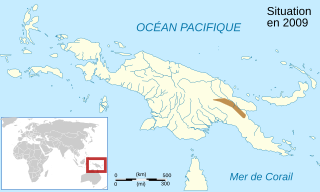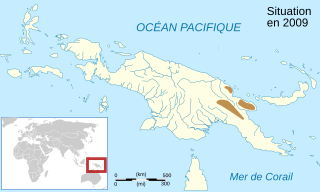
Copiula guttata is a species of frog in the family Microhylidae. It is endemic to Papua New Guinea and known from around the head of the Gulf of Papua in the Gulf and Chimbu Provinces. The specific name is the Latin adjective guttata that means "spotted" and refers to the dorsal colour pattern of this species. Based on molecular evidence, it was transferred from Austrochaperina to Copiula in 2016.

Barygenys atra is a species of frog in the family Microhylidae. It is endemic to eastern New Guinea and is known from the Morobe and Northern Provinces, Papua New Guinea. Common name Gunther's Papua frog has been proposed for it.
Barygenys cheesmanae is a species of frogs in the family Microhylidae. It is endemic to eastern New Guinea and is only known from Mount Tafa in Central Province, Papua New Guinea. The specific name cheesmanae honors Lucy Evelyn Cheesman, an English entomologist, explorer, curator at London Zoo, and collector of the holotype. Common name Cheesman's Papua frog has been coined for this species.
Barygenys nana is a species of frog in the family Microhylidae. It is endemic to New Guinea and is known from the mountains of Eastern Highlands and Western Highlands Provinces, Papua New Guinea. The specific name nana refers to the small size of this species. Common name highland Papua frog has been proposed for it.
Callulops boettgeri, also known as Boettger's Callulops frog, is a species of frog in the family Microhylidae. It is endemic to Halmahera in the Maluku Islands of Indonesia. It is only known from the holotype collected from Galela in 1894. The genus-level placement of this little known frog has changed many times, and it is still unclear whether it should be placed in some other genus.
Callulops doriae is a species of frog in the family Microhylidae. It is endemic to Papua New Guinea and occurs in the eastern mainland Papua New Guinea and in Tagula Island, Louisiade Archipelago. It is the type species of the genus Callulops erected by George Albert Boulenger in 1888. Common name Doria's callulops frog has been coined for this species.
Asterophrys eurydactyla is a species of frog in the family Microhylidae. It is endemic to New Guinea and known from the Onin Peninsula in Western New Guinea (Indonesia), and from the Star Mountains in the Western Province in Papua New Guinea, close to the border with Western New Guinea; there are some doubts whether this easternmost record is conspecific with A. eurydactyla. Common name Danowaria callulops frog has been proposed for this species.
Callulops marmoratus is a species of frog in the family Microhylidae. It is endemic to Papua New Guinea and only known from its type locality, Crater Mountain Wildlife Management Area in the southwestern Chimbu Province, on the southern escarpment of the New Guinea Highlands.

Callulops personatus is a species of frog in the family Microhylidae. It is endemic to the northern lowlands of central New Guinea and occurs in both Western New Guinea (Indonesia) and Papua New Guinea. The specific name personatus is Latin adjective meaning "masked", in reference to the head coloration. Common name Maprik callulops frog has been proposed for it.

Callulops robustus is a species of frog in the family Microhylidae. It has traditionally been considered as wide-ranging species found in both Western New Guinea (Indonesia) and Papua New Guinea. However, it is likely that specimens from the type locality, Misima Island, and New Guinea represent different species. If so, name Callulops robustus belongs to the Misima Island species, and the mainland species is unnamed. Other island populations may or may not belong to Callulops robustus. Callulops microtis from the mainland has already been removed from synonymy with Callulops robustus.

Cophixalus parkeri is a species of frog in the family Microhylidae. It is endemic to Papua New Guinea where it occurs in the central mountainous region between Chimbu and Morobe Provinces. The specific name parkeri presumably honours Hampton Wildman Parker, an English zoologist and herpetologist to whose perusal Arthur Loveridge sent the holotype. Common name Papua rainforest frog has been coined for it.
Cophixalus riparius is a species of frog in the family Microhylidae. It is endemic to Papua New Guinea and occurs in the New Guinea Highlands in Madang, Southern Highlands, and Western Highlands provinces southeastward to the Morobe Province. The specific name riparius refers to the creek-side habitat from which many specimens in the type series were collected. Common name Wilhelm rainforest frog has been coined for this species.

Cophixalus shellyi is a species of frog in the family Microhylidae. It is endemic to Papua New Guinea and occurs in the New Guinea Highlands as well as in the Adelbert Range and on the Huon Peninsula. The specific name shellyi honors Father Otto Schellenberger ("Shelly"), an American missionary and former professor in mathematics who collected the type series.
Hylophorbus infulatus is a species of frog in the family Microhylidae. It is endemic to New Guinea and known from its type locality, Arau in the Kratke Mountains, as well as from the Adelbert Range, both in Papua New Guinea. Common name Arau archipelago frog has been proposed for it.
Oreophryne notata is a species of frog in the family Microhylidae. It is endemic to Papua New Guinea and known from two localities, Ialibu, its type locality in the Southern Highlands Province, and Tabubil in the Western Province. It might occur more widely. The specific name notata is from Latin nota meaning a "mark" or "letter" and refers to the diagnostic U-like pattern on the lores.
Copiula alpestris is a species of frog in the family Microhylidae. It is endemic to Papua New Guinea and known from the Western Highlands, Chimbu, and Eastern Highlands Provinces at elevations of 1,800–2,800 m (5,900–9,200 ft) above sea level. The specific name is a Latin adjective meaning "living in high mountains", in reference to its relatively high-altitude habitats. Based on molecular evidence, the species was transferred from Oxydactyla to Copiula in 2016.
Sphenophryne stenodactyla is a species of frog in the family Microhylidae. It is endemic to Papua New Guinea and known from the New Guinea Highlands in the Western Highlands, Chimbu, Eastern Highlands Provinces at elevations between 2,490 and 4,000 m above sea level. The specific name stenodactyla is derived from the Greek words stenos meaning "narrow" and dactylos meaning "digit".
Xenorhina zweifeli is a species of frog in the family Microhylidae. It is endemic to New Guinea and is only known from the Bewani and Hunstein Mountains in northern Papua New Guinea. The species is named for American herpetologist Richard G. Zweifel, a specialist in New Guinean herpetology and microhylid frogs; he is also said to share "characteristically terse vocalizations" with this frog.
Xenorhina parkerorum is a species of frog in the family Microhylidae. It is endemic to New Guinea Highlands and occurs in both eastern Western New Guinea (Indonesia) and western Papua New Guinea. Common name Imigabip snouted frog has been proposed for it. The specific name parkerorum honours herpetologists Fred Parker and Hampton Wildman Parker.

Callulops omnistriatus is a species of frog in the family Microhylidae. It is endemic to Papua New Guinea and is known from the southern slope of the Central Highlands, Southern Highlands Province. The type locality is in the vicinity of the Moro Airport.








